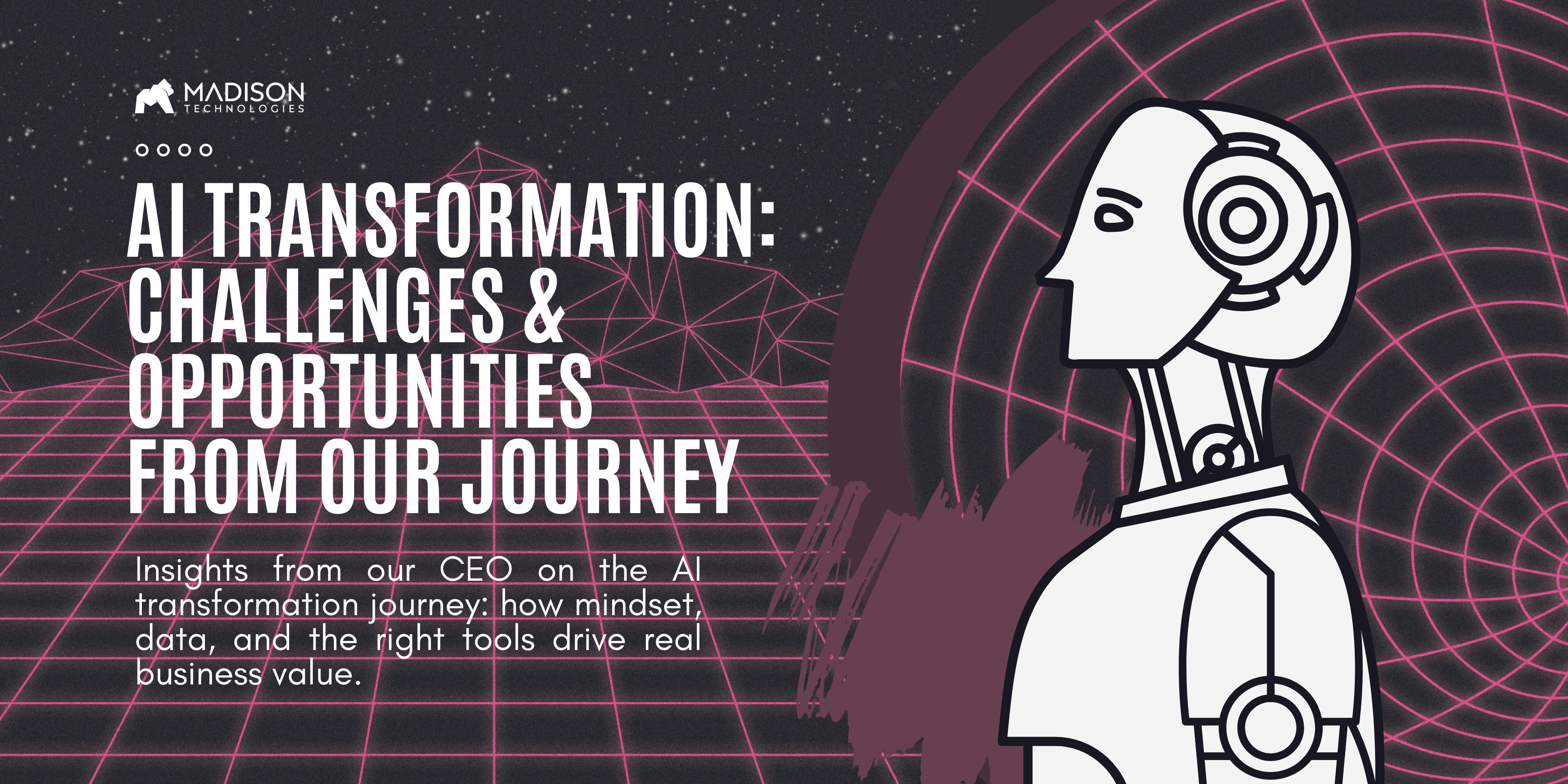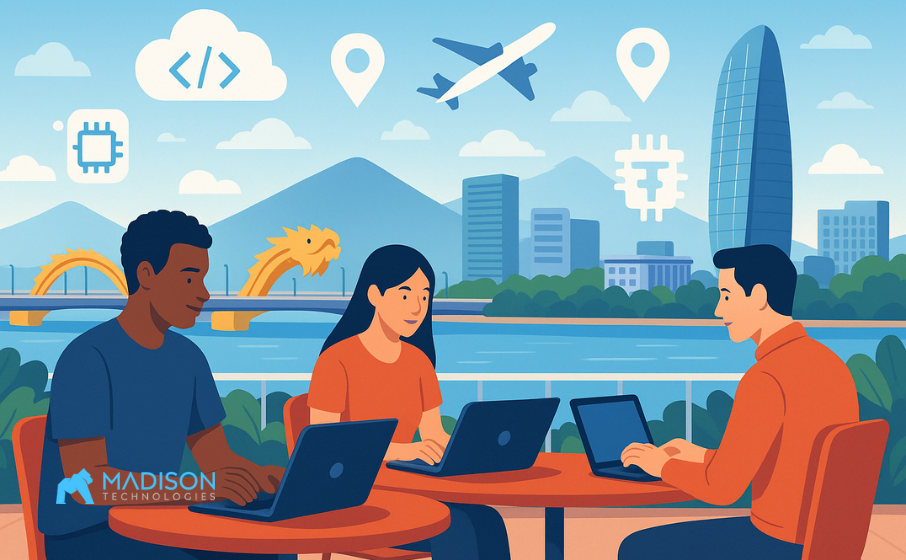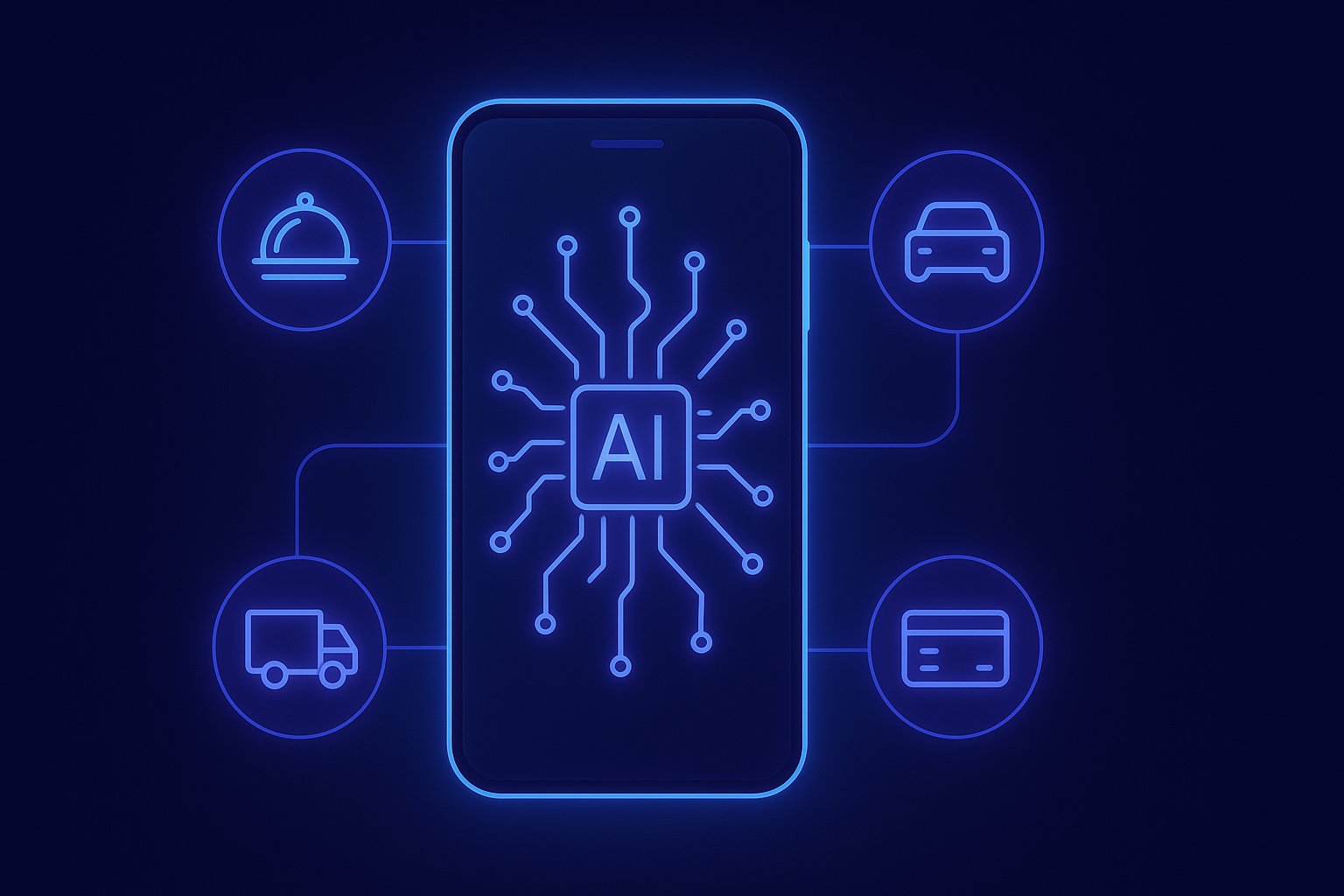AI Transformation: What, Why, How – Real Challenges & Opportunities from Our Own Journey

Artificial Intelligence (AI) is no longer a distant future—it’s already here, changing how businesses operate, grow, and compete. But between the excitement of innovation and the reality of implementation lies a tough, often messy journey—especially for companies that are serious about applying AI in a way that actually delivers business value.
At Madison Technologies, we decided to face that journey head-on.
I’m not just speaking as a CEO—I’m a developer who’s been in the IT industry for nearly 20 years. I’ve built systems, written countless lines of code, and taken pride in what I know. But when it came to AI, I realized I had to put all that aside. I had to unlearn and relearn. Not for the sake of chasing trends, but because I knew this was a tool that, if used right, could help our business—and our clients—solve real challenges.
I won’t sugarcoat it. The process was uncomfortable. We ran into obstacles, questioned our capabilities, and made mistakes. But in the end, what we gained was more than just AI know-how—we developed a deeper understanding of transformation itself.
In this article, I’ll share our story—what we did, why we did it, how we did it, and most importantly, what we learned from it. If you’re someone who’s looking at AI with interest but also hesitation, I hope this helps. I’ll tell it straight, the way I know best—no fancy words, just honest lessons from someone who’s walked the path.
What is AI Transformation?
When people talk about AI transformation, the first images that come to mind are often tools, automation, or replacing human labor. But based on our real experience at Madison, that’s a very narrow view.
AI transformation isn’t about technology—it’s about mindset.
It’s a shift in the way a company thinks, works, and grows. It’s the willingness to look at everything—processes, roles, decision-making—and ask: Can we do this differently? Can we do this smarter?
At its core, AI transformation means:
- Reevaluating existing workflows to identify where intelligence and automation can improve outcomes.
- Reimagining value creation—not by adding more people or hours, but by letting machines handle what they do best so humans can focus on what truly matters.
- Reskilling and upskilling teams so they not only use AI but understand how it supports their goals.
This shift doesn’t happen overnight—and it definitely doesn’t happen without people.
At Madison, we learned early that AI is only as effective as the people behind it. That’s why we made training and mindset development a core part of our transformation journey. We focused not just on AI tools, but on growing leadership and core competencies across the company.
Because real AI transformation doesn’t start with software—it starts with people.
Why Did We Start Our AI Transformation?
At Madison, our journey with AI didn’t start with a grand plan or a flashy innovation goal. It started with a simple but important question: How can we do better—for our clients, for our team, and for the future?
We realized that while we had solid technical capabilities, the real bottleneck was not tools—it was mindset.
AI transformation, for us, was never just about technology. It was a mindset shift—a shift from “doing things the way we always have” to constantly asking:
Is there a smarter, faster, more meaningful way to solve this?
It challenged us to rethink our roles, our workflows, and even our assumptions.
But to truly adopt that mindset across the company, we knew one thing was essential: developing our people.
At Madison, we don’t believe in simply hiring talent—we believe in growing leaders. That’s why our people development strategy starts with:
- Leadership competencies – Every individual in the company is encouraged to understand themselves deeply: their vision, their goals, and what leadership means in their context. We believe when you can lead yourself, you naturally inspire and empower others. And that’s how leaders create more leaders.
- Core competencies – We treat each team member as a business partner. They are expected to align with our company’s vision, mission, and core values. This shared understanding is the foundation that helps us move forward as one unified team.
- Professional competencies – Skills and tools matter, of course. But only when built on a strong base of self-leadership and shared purpose.
So why did we start our AI journey?
Because we believed—and still believe—that technology only works when people are ready. And that means investing in mindset, leadership, and alignment first.
The Real Challenges We Faced
We didn’t step into AI transformation with a perfect plan. Like many others, we started with curiosity—driven by the hype that AI could boost productivity, reduce effort, and unlock new opportunities.
But the reality? It was much more complicated than that.
1. We misunderstood AI—right from the beginning
As someone who has worked in IT for nearly 20 years, I thought I had a decent grasp on technology. But when I started learning about AI seriously, I realized that most of what I had heard was just the tip of the iceberg. The media made it sound like magic. The truth? I had misunderstood what AI really was and what it could (and couldn’t) do for business.
That realization was humbling—and eye-opening.
2. Internal resistance was stronger than expected
When I encouraged our team to apply AI in simple daily tasks—like reducing an 8-hour task to 6 hours using prompting—what I faced was not excitement, but pushback. People were used to the old ways. Some even felt the need to “prove” they were better than AI, fearing it might replace them.
This wasn’t just a tech issue—it was emotional, human. And it taught us that AI transformation is first and foremost a mindset shift.
To tackle this, we ran internal talks and training sessions—not just about tools, but about why change matters, and how AI is here to support, not replace. Slowly but surely, the shift began.
3. Data confusion slowed us down
In the beginning, we didn’t even know what data we needed. So of course, we didn’t have it. And without quality data, any AI effort is limited to simple, surface-level tasks. When it comes to more complex use cases—like prediction, recommendation, or decision-making—good data isn’t optional, it’s critical.
This made us completely rethink how we handle and structure data across the company.
4. One success, many lessons
Eventually, we achieved a small but meaningful win: we successfully optimized an 8-hour task down to 6 hours using AI, with the same—or even better—quality. That win became our internal case study, and from there we created a new KPI: tracking how effectively each team member uses AI to optimize their work.
5. Drowning in tools
With new AI tools popping up daily, we were overwhelmed. Every tool promised speed, productivity, innovation—but most of them didn’t fit our workflow. We quickly realized: if we kept chasing tools, we’d never catch up.
Instead, we went back to the fundamentals: learning the basics of Gen AI, LLMs, machine learning, data science, RAG, and prompt engineering. Once we built that foundation, it didn’t matter which tool came next—we could pick it up fast and use it well.
Lessons We Learned
Our journey with AI wasn’t without its bumps, but the lessons we gained along the way were invaluable. These lessons are now the foundation of our AI strategy—both internally and for our clients.
1. AI is more about mindset than technology
The biggest lesson we learned is that AI transformation starts in the mind. It’s not just about installing a tool or using a new algorithm. It’s about rethinking how you approach work, how you solve problems, and how you empower people to think beyond traditional methods.
For us, AI wasn’t the ultimate answer—it was the lens through which we saw possibilities. And once we embraced this mindset shift, the technology followed.
2. Change is hard, but it’s worth it
We weren’t naive. We knew implementing AI would be a challenge. But we didn’t fully understand how much resistance we’d face from the team, who were deeply attached to their ways of working. We had to put extra effort into changing mindsets, and that meant time and patience.
But the payoff? Once the team understood that AI wasn’t here to replace them, but to help them work smarter, the transformation started happening. People embraced it, and it became a part of our DNA.
3. Data is the backbone of AI
We could talk about AI all day, but without good data, it’s useless. The right data isn’t just important—it’s essential. We learned the hard way that AI without data is like a car without fuel. You can have the fanciest tools, but if you don’t have the quality data to back them up, you’re stuck.
Now, we make sure that every AI use case starts with a solid foundation of clean, structured, and accessible data.
4. Start small, but think big
One of our early mistakes was trying to do too much too quickly. We learned that it’s better to start with small, focused projects that can show clear results—like the 8-hour to 6-hour task optimization—then use those wins to build momentum.
Once we proved the value of AI in these small tasks, we could scale it. And that scaling wasn’t about implementing AI everywhere at once, but doing it where it matters most.
5. The learning never stops
Even now, we’re still learning. The world of AI moves fast, and it’s easy to get lost in the noise of new tools and trends. But instead of chasing the latest shiny object, we focused on building a solid foundation of AI principles, which allows us to pick up any new tool and make it work for us.
Our commitment to continuous learning, and investing in our team’s leadership and core skills, has been critical in making AI a sustainable part of our operations.
How We Can Help You
We’ve learned a lot on this AI journey—and we’re ready to share those lessons with you. At Madison Technologies, we’ve built our expertise around not just applying AI, but ensuring it delivers real value for the business, and we believe we can do the same for you.
1. We Help You Develop the Right AI Mindset
AI transformation is a mindset shift, not just a technical change. We work with companies to ensure their teams not only understand AI’s potential, but also embrace it as a way to work smarter, not harder.
Our team is experienced in leading this shift, having navigated the resistance and challenges ourselves. We help you train your people, get buy-in from the leadership, and build a culture that is open to AI and its possibilities.
2. We Guide You in Choosing the Right Tools
With so many AI tools out there, it’s easy to get lost. At Madison, we’ve cut through the noise and focused on building foundational knowledge—so we can guide you through the process of choosing and implementing the right tools for your specific needs.
Whether you need AI for automation, reporting, data analysis, or decision-making, we’ll help you pick the right solution that works for your business, not just the latest tool on the market.
3. We Build Strong Data Foundations
AI only works when the data is right. We’ll help you audit your data, identify gaps, and implement systems that ensure your data is structured, clean, and accessible. This is key to making AI work across different tasks, whether it’s simple automation or complex decision-making.
4. We Implement AI Step-by-Step
At Madison, we don’t believe in going all-in without knowing the results. We start with small, well-defined use cases that will deliver clear, measurable results—just like we did with our 8-hour task optimization. From there, we build a roadmap for scaling AI, using data-backed insights to make sure each step delivers value.
5. We Support You on Your AI Journey
Our approach is collaborative—we work side by side with your team to ensure that AI is seamlessly integrated into your operations. With ongoing support, training, and knowledge sharing, we make sure that you’re never alone on your AI journey. We are here for the long-term, not just to implement AI, but to help you adapt, evolve, and succeed with it.
Conclusion
AI transformation isn’t just about adopting new technology—it’s about embracing a new way of thinking. It’s about seeing the potential in your business, your team, and your processes, and understanding that AI can help unlock that potential in ways that were never possible before.
But the journey is not without its challenges. It takes time, patience, and a willingness to adapt. And it’s not just about tools or data—it’s about people. The mindset shift is key, and the real success comes when every member of your team is ready to lead themselves, embrace the change, and work towards a common goal.
At Madison Technologies, we’ve walked the path of AI transformation, and we’ve learned that the true power of AI is not in the technology itself, but in how you use it to empower your people and optimize your business.
If you’re ready to take the first step in your own AI journey, we’re here to help. Whether you’re just starting out or looking to take your AI efforts to the next level, we’ve got the experience, knowledge, and mindset to help you succeed.






